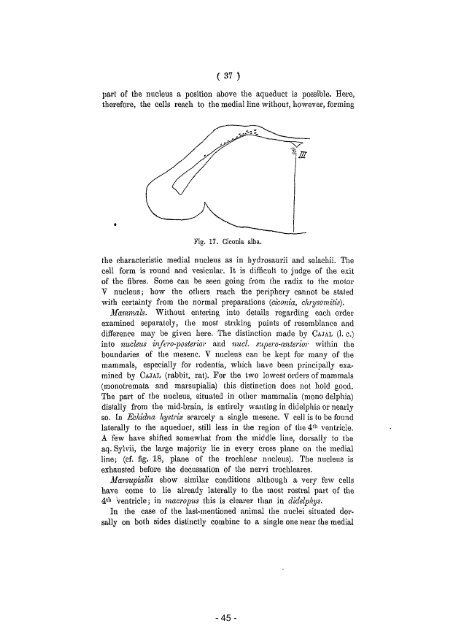Proceedings of the section of sciences - DWC - KNAW
Proceedings of the section of sciences - DWC - KNAW
Proceedings of the section of sciences - DWC - KNAW
Create successful ePaper yourself
Turn your PDF publications into a flip-book with our unique Google optimized e-Paper software.
( 37 )<br />
part <strong>of</strong> tbe nucleus a position above <strong>the</strong> aqueduct is possible. Here,<br />
th el'efore , <strong>the</strong> cells reach to <strong>the</strong> medialline without, howevel', fOl'ming<br />
Fig. 17. Ciconia alba.<br />
tbe characteristic medial nucleus as in bydl'osaurii and selachii. The<br />
ceU form is l'ound and vesicular. It is difftcuH to judge <strong>of</strong> <strong>the</strong> exit<br />
<strong>of</strong> <strong>the</strong> fibres. Some can be seen going fl'om <strong>the</strong> radix to <strong>the</strong> motor<br />
V nucleus; how <strong>the</strong> o<strong>the</strong>rs reach <strong>the</strong> periphery cannot be stated<br />
with certainty from <strong>the</strong> normal preparations (ciconia, chrysomitis).<br />
]fammals. Without entering into details regal'ding each order<br />
examined sepal'ately, <strong>the</strong> most strlking points <strong>of</strong> resemblance anel<br />
difference may be given here. The distinction made by CAJAL (1. c.)<br />
into nucleus infao-posterior and nucl. supero-anteriol' witbin tbe<br />
boundaries <strong>of</strong> <strong>the</strong> mesene. V nucleus can be kept fol' many <strong>of</strong> tbe<br />
mammais, especially for l'odentia, which have been principally examined<br />
by OAJAL (rabbit, rat). For <strong>the</strong> two lowest orders <strong>of</strong> mammals<br />
(monotremata and marsupialia) this distinction does not hold good.<br />
The part <strong>of</strong> <strong>the</strong> nucleus, situated in o<strong>the</strong>r mammalia (mono delphia)<br />
distally from <strong>the</strong> mid-brain, is entirely wanting in didelphict or nearly<br />
sa. [n Echidna hystrix srarcely a single mesenc. V cell is to be found<br />
laterally to <strong>the</strong> aqueduct, still less in <strong>the</strong> reg ion <strong>of</strong> <strong>the</strong> 4 th ventl'icle.<br />
A few have shifted somewhat fl'Om <strong>the</strong> middle line, dOl'sally to <strong>the</strong><br />
aq. Sylvii, <strong>the</strong> large mttjoriiy lie in every cross plane on <strong>the</strong> medial<br />
line; (cf. fig. 18, plane <strong>of</strong> <strong>the</strong> trochlear nncleus). The nucleus is<br />
exhausted befOl'e <strong>the</strong> decussation <strong>of</strong> <strong>the</strong> nervi trochleal'es .<br />
.J..11arsupialia show similar conditions although a very few ceUs<br />
have come to lie already latel'ûUy to <strong>the</strong> most rostral pa,d <strong>of</strong> <strong>the</strong><br />
4 th ventriele ; in 1JWC1'OPUS tbis is cleal'er than in clidelphys.<br />
In <strong>the</strong> case <strong>of</strong> <strong>the</strong> last-mentioned animal <strong>the</strong> nuclei situated dol'sally<br />
on both sides distinctly combine to a single one near <strong>the</strong> medial<br />
- 45 -

















